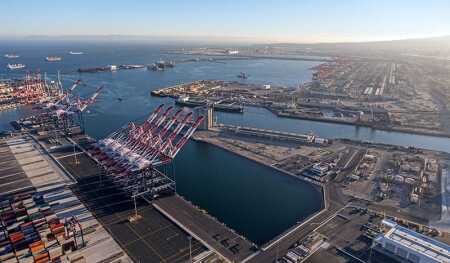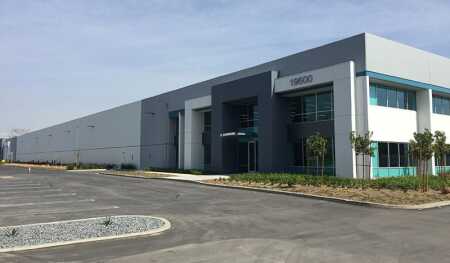A year after the opening of the Panama Canal expansion, rents for industrial space around the Port of Los Angeles are at an all-time high and vacancy rates are hovering around 1 percent.
Tenants are “fighting for infill locations,” says Griffin Cogorno, vice president of client services for Unire Real Estate Group. “The amount of people looking to take space has been mind-blowing.”
Cargo traffic to Los Angeles and other West Coast ports was expected to drop in the wake of the much-anticipated canal expansion, as Asian shippers diverted cargo through the canal to the East Coast. In fact, container shipments through Gulf Coast and East Coast ports have soared since the new locks opened in June 2016. But the drop-off in cargo to the West Coast has not materialized.
The volume of TEUs (containers) to the ports of Los Angeles and Long Beach actually was up 5.2 percent in the first half of 2017, compared with a year earlier, according to a new report from Transwestern, the real estate advisory.
“In terms of container volume, the Panama Canal expansion resulted in zero slowdown in the Port of Los Angeles and the port of Long Beach,” says Michael Soto, Transwestern’s research manager for southern California.
Los Angeles is not alone. Up and down the West Coast, prime industrial space around ports is in short supply. Vacancy rates for industrial space in Seattle-Tacoma, Oakland, and Vancouver remain below 5 percent, according to a recent report by JLL. In Long Beach, south of Los Angeles, only 1.8 percent of space is available.
West Coast ports have been bolstered by the growth of e-commerce and a surging consumer economy, analysts say. The competition for space between fast-growing third-party-logistics companies (3PLs) has intensified, helping offset any decline from a shift in canal traffic.
The L.A. industrial market is “ground zero for a lot of that stuff,” Soto says.
Los Angeles has the highest industrial space rents of the 14 “gateway” U.S. ports tracked by JLL, averaging about $9.65 per square foot ($103.83 per sq m), followed by Oakland at $9.50 per square foot ($102.22 per sq m) and $8.70 per square foot ($93.61 per sq m) in Long Beach. New York/New Jersey is the most expensive industrial port market on the East Coast, averaging $8.23 per square foot ($88.55 per sq m), according to JLL.
Around the United States, vacancy rates in the gateway ports “are near historically low levels,” according to JLL. In the wake of the canal expansion, growth has been “robust” in Gulf Coast and East Coast ports, with Baltimore, Charleston, Houston, Jacksonville, Miami, and Virginia all reporting record traffic last year, JLL found.
Of the 25.4 million square feet (2.4 million sq m) of industrial space under construction, 65 percent is on the East Coast and the Gulf Coast, as ports race to meet demand from new canal traffic, according to JLL. About 50 percent of the Class A industrial space under construction is already leased, says Mehtab Randhawa, vice president of Americas industrial research.
“There is a lot of potential there from the canal expansion,” Randhawa says.
The West Coast’s share of total container traffic to the United States has been declining in recent years, but JLL is “not expecting any slowdown [in the industrial markets] on the West Coast, even though volumes are expected to shift,” says Walter Kemmsies, managing director of JLL’s U.S. ports, airports, and global infrastructure group. The “underlying fundamentals” remain strong, he says.
Faced with the scarcity of developable land, some West Coast building owners are growing more creative. Last year, ProLogis announced plans to build a three-story, 580,000-square-foot (54,000 sq m) facility in Seattle. While multistory distribution facilities are common in Asia and Europe, they are a rarity in the United States.
“The only way the logistics sector can compete is with this more dense format,” Prologis chief executive Hamid Moghadam told the Wall Street Journal at the time.
In the Los Angeles area, with demand strong, tenants are struggling to find facilities that meet their needs, local executives say. “Today, with the amount of product, tenants [in Los Angeles] really have to push the wish list aside,” says Cogorno of Unire.
New space is quickly gobbled up. Last year, UPS leased 525,400 square feet (48,800 sq m) in a facility developed by Clarion Partners in Compton, in a deal valued at $44 million, described by local media as one of the largest industrial leases in Los Angeles County.
The geographic definition of “port-related” industrial space is expanding in Los Angeles, as shippers look for new facilities. In the area known as the Inland Empire, 75 miles (121 km) from the Port of Los Angeles, the vacancy rate for industrial space hit an all-time low of 3.3 percent at the end of the second quarter, Transwestern reports. To meet demand, 21.5 million square feet (2 million sq m) of space is under construction in the area, the advisory says.
“As rates went up [around the port], demand went up and people started to look to other areas,” says C.J. Collins, a broker with Voit Real Estate Services, a southern California–based commercial property advisory.
Little land is available close to Los Angeles or Long Beach for new industrial development, analysts say. At the same, several cities in the Los Angeles area are rethinking their approach to industrial development. In March, the municipal government of Carson, a city near the Long Beach port, placed a temporary moratorium on new industrial development.
“You can’t find the land [for new projects], and if you can it is too expensive,” Collins says.
More than 7 million square feet (650,000 sq m) of industrial space is under construction in Los Angeles, including several redevelopment projects, according to Transwestern. But new supply is unlikely to shift the industry dynamics, Soto says.
“It’s not going to dent demand,” he says.






